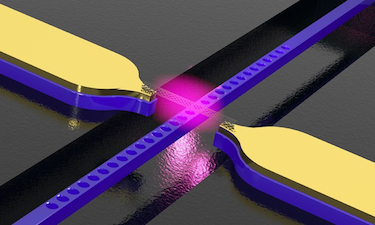A single carbon nanotube has been used as a scalable and tunable light source and integrated into a nanoscale waveguide by researchers in Germany. The nanotubes are part of a photonic-crystal waveguide that converts electric signals into light. The researchers hope their work could advance the field of optoelectronics and help to produce faster computer chips.
Light it up: the carbon-nanotube light source
Thanks to the vast numbers of data being generated and shared on a daily basis, traditional electronic processing techniques have been struggling to keep up. Instead, researchers have been focusing on optical-telecommunication systems that contain integrated optical circuits with nanoscale photonic emitters with specific properties. Indeed, many communication systems today already use light as the best and fastest medium to transfer data, thanks to its speed and energy-efficiency. For example, fibre-optic cables are routinely used as waveguides for the global transmission of telephone and Internet signals.
To make use of these properties on a much smaller scale, such as a computer chip, a stable nanoscale light source is required, with optical properties that can be easily tailored. The source also needs to be electronically triggered and be easily integrated into an on-chip waveguide network.
Now, researchers at the Karlsruhe Institute of Technology (KIT) in Germany and colleagues have taken an important step from fundamental research towards application by integrating microscale carbon nanotubes (CNTs) into a nanostructured waveguide that is capable of converting incoming electric signals into clearly defined optical signals.
When an electric voltage is applied, the nanotubes produce photons, acting as a compact light source. The teams waveguides are processed such that the wavelength at which the incoming light is transmitted is precisely defined. The researchers used electron-beam lithography to engrave the micrometre-long waveguides with nanoscale cavities that determine the waveguides optical properties. The resulting photonic crystals reflect the light in certain colours, much like the structural colours observed on the wings of butterflies.
"The nanostructures act like a photonic crystal and allow for customizing the properties of light from the carbon nanotube," say Felix Pyatkov and Valentin Fütterling of KIT. "In this way, we can generate narrow-band light in the desired colour on the chip."
The researchers positioned 1 μm-long and 1 nm-wide CNTs on metal contacts in a transverse direction to the waveguide. They also developed a process so that the nanotubes could be integrated into highly complex structures. Using "dielectrophoresis" – a method originally used in biology to separate particles using inhomogeneous electric fields but now often used to deposit, manipulate and orient nanoparticles – the researchers deposited the CNTs from their solution and arranged them vertically onto the waveguide.
The KIT team says that its work shows how CNTs meet the requirements of the next generation of computers that combine electronic components with nanophotonic waveguides. The signal converter bundles the light about as strongly as a laser and responds to variable signals with high speed. CNTs are also highly tunable sources because they can be easily modified simply by changing the cavity length.
The researchers also point out that their method eliminates any broadening of the lights linewidth (which results in a loss of information) caused by temperature or any surface interactions, because the linewidth of the molecular emitter is determined only by the quality factor of the photonic crystal. Indeed, the optoelectronic devices developed by the team can already be used to produce light signals in the gigahertz frequency range from electric signals, which is compatible with active photonic networks.
The research is published in Nature Photonics.

